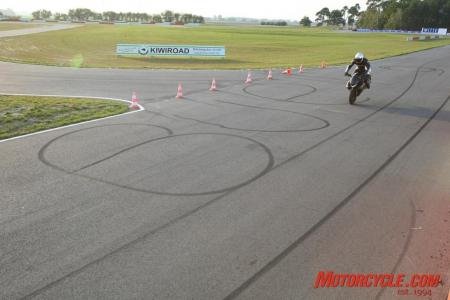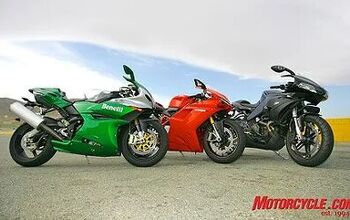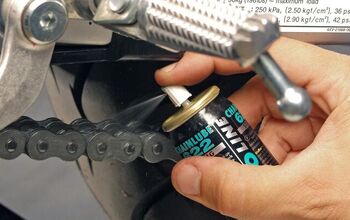2009 Buell 1125CR Review - Motorcycle.com
Guten Morgen! Buell released its new café racer this week among the entire 2009 model lineup.
Paul James, Buell’s Director of Product Communication, presented them to the press near the world’s first boulevard, Unter der Linden, just steps away from the deconstructed Berlin Wall. More specifically, we were beneath the urban streets of Berlin at the Potsdamer plaza metro station, in a rave-ready concrete space hidden between public floors of the station. Blending in to the landscape for the common folk, yet unique and worth taking a peek – just like the Buell 1125CR. It’s more than just “Harley’s sportbike” as Buells are often described. The CR is ready to compete against the Japanese.
The 2009 1125CR café racer was revealed in the shadow of a changing city, amidst both the historical and modern architecture as well as a sprawling countryside that is timeless.
Das Ist Good!
The overall 2009 Buell line-up consists of six models in three distinct lines: street, adventure and sportbike. Models vary by engine configuration and design intent but continue the melting pot culture that has grown to exemplify the “American” ideal. Consisting of parts manufactured in China, Italy, Germany as well as the US, the global synergy of buyer, builder and supplier has blurred into one complete package in the form of the 1125CR.
We all know from my last report, that the new Buell café racer was going to be unveiled and journalist tested in Germany despite being ready to ride at your local raceway for the last few weeks. We too wondered why we were forced to wait and why Buell chose a European center as the proving grounds of an American sportbike.
Always on the scene, poking our cameras where they belong, this time Fonzie was in the saddle to experience the café racer in action. On the first day of two in Germany we warmed our rubbers on the one-year-old super-smooth pavement of the Spreewaldring testing center just 30 minutes south of Berlin, Germany. Buell intended the day to be a focused moment on braking, cornering and acceleration as well as how the mapping updates performed on the Helicon engine. I chalked it up as a refresher course in track riding as well. Round and round like a merry old jester, clicking off laps like there was no tomorrow, the hours seemed to be shorter and shorter as the day progressed. Aside from learning about the 146hp Helicon in a controlled environment, I had a blast getting my first track time in over two years on a café racer.
Thankfully, the technical 1.67 mile track is more like the streets of willow than the big one over here in California –perfect for the steep-rake XB-like 1125CR. It doesn’t take anyone long to notice the CR hasn’t much in the way of air flow management, favoring a minimal bikini windscreen similar to the XB model line. Without the big bubble to push away the high-speed atmosphere, head shakes are eminent and achievable above the tonnage mark indicated on the digital speedo. The “quiet zone” as Buell calls the space behind the fairing of the 1125R is now gone, leaving you more exposed to the elements. This is where fashion wins over function – your inner hooligan can’t hide from the aero forces on the CR. It’s built for fun, not racing. Big speed however doesn’t completely ruin the fun. When we got our kicks on the autobahn, we only had a few floating wobbles above a hundred miles per hour.
Spreewaldring SidebarAs a newly constructed training facility along a common path of weekend warriors, the STC offers something I’d never heard of before – I’ll call them micro-track days. For 20 Euros, a rider can stop by, prove his or her riding proficiency and take a 20-minute session on the track and move on.
Translating to nearly $90 USD per hour, it doesn’t work out to be a deal when you compare the time to a full track day in the US, but it’s an interesting idea. It’s surely worth the Euros to burn off that road rage and cheaper than visiting a brothel.
Case in point, we rode faster on the open roads than we did on the track. It’s not only easier to go faster in a straight line without turns or chicanes, it’s legal here! On the track, it was hard to get above fourth gear, but in the country of the autobahn, full overdrive can be achieved. Police will stop you if you’re riding recklessly, but not for your speed. Speed isn’t limited, but aggressive riding isn’t tolerated in Germany. Luckily the locals know how to drive and actually use their mirror, turn signals and lane discipline. It is amazing how much more rewarding road travel can be when everyone gets along! And when you can take your competition to the track at a moments notice, life as a motorcyclist is all the better in Europe.
As we reported in our Oddball Literbike Shootout, the leaf spring affect created from the construction of that fuller fairing and its supports have been lost to more roadway feedback with the stiffer and more compact clubman-style aluminum handlebars. Tapered and tough looking, they’ve got a demonic, horn-like appearance. Only slightly lower than the R models by geometry, the rider stance stays aggressive unless you decide to buy the optional riser upright bar.
While Pete thought the R “gave a penetrating stare,” The styling of the new CR is downright menacing with its ‘browed’ headlight, minimized windscreen and popped-collar-like fairing side covers. That smaller front end now also contains a single-piece headlight.
Mirrors are mounted differently form the R and now hold up to 80+ speeds. With the accessory higher handlebar however, the mirrors are placed more within your rearward sightline, making you look under your armpit instead of over your forearm for a clear view behind you.
Surprisingly, the lesser bodywork doesn’t produce a lighter bike overall when compared to the 1125R. At high speeds, even without the comparatively massive front fairing, the floating front end is still there thanks to the side fairing scoops. The CR showed us the fastest route to the next café can be had at nearly 154 mph, just slightly slower that the more aerodynamic R, which reportedly can achieve a top speed of 162mph. A short but very sweet taste of speed indeed. I made it about as high as the 215 mark (kilometers per hour) before we caught up to traffic in the restricted portion of the roadway. Contrary to popular belief, not every mile of the autobahn has an unlimited speed limit. Good judgment, keen attention and precise driving skills are required. Thankfully, this seems commonplace in Germany, as was made evident by the M5 that calmly slipped into and back out of our rabid pack of riders at over 200kph.
When I talked to the coaches at the Buell Inside Pass track day in Las Vegas to get their in-the-saddle opinions on the updated models, they varied. Having ridden both the ‘08 and now recently the ‘09 models, I could say they’ve flogged the 1125® at over a dozen tracks this year instructing current as well as future Buell owners in the safety of a closed course. Dennis Baker, a MSF instructor and philanthropist from Detroit has ridden the R and CR back to back this month and says that he’d buy the R for his riding purposes - being mostly track use. He goes on to say “the bubble helps at high speeds without having any steering dampener.”
I’d taken my last session on the Waldow Germany track aboard the 1125R just to compare the two models, never having ridden the R, and my first impression was that it felt as big at it looked. With the term flagship model bouncing around in my helmet for that 20-minute ride, I could easily see what Dennis meant. The only-slightly obstructive fairing did make for a quieter ride, although I never topped the ton mark on that tiny track.
Covering the frame-matched black powder wheels are Pirelli’s patented zero-degree steel-belted radial MIRS construction Diablo Corsa IIIs. These are the same construction found on the powerful sport-touring alternate-tire-for-the-1125 Pirelli Strada. The Corsa III did all it could to smooth out the bumps in the road on our street ride, but it seems like they just paved over the cobblestones in some areas. Although they did well, nothing but a Cadillac will truly tame the East German roadways. The long lasting double compound Diablo Corsa IIIs are perfect for the big-bore street bikes. Designed with long lasting street capability as well as great racing performance afforded by the higher friction compound in the relatively softer shoulder, the DCIIIs give greater traction and better handling than the preceding Corsa. Another Inside Pass track coach told me he finally replaced his first rear after 1100 all-track miles, that’s long wearing in my book. The street fighting target market receives maximum lean angle as well as more confident acceleration out of the corners.
Although the Autobahn was a highlight of our ride, speed isn’t everything. The German countryside was actually more telling and enjoyable. Blasphemous to say such a thing, I know, but it’s on the street where we got to experience what most owners will. I was able to experience the comfort, performance handling, as opposed to just hanging on for dear life.
To answer those questions, we toured 250 kilometers around the East German countryside to find no ergonomic gripes, surprisingly. Typical of a more aggressive sport-standard motorcycle, the wrist pressure is the first to spoil my day, but not so on the CR. Buell noted the wrist degree angle in its press material as 138 degrees. I’d never noticed these figures, but I expect to find that useful in the future as a comfortable benchmark.
For 2009, the clean-sheet BRP-Rotax powerplant that we’d first seen on the 2008 125R has undergone some updates. Thankfully Buell’s linear pull and torque curve still reside. Chances are, you’ve already heard about the fueling issues and the otherwise reported slow acceleration. Buell responded with remapped spark and fuel maps which reportedly provide 20-plus percent better fuel economy, reduced rider-felt heat, improved starting and the all important low-speed drivability. EIC Duke called the acceleration of the 2008 Helicon “lethargic” down the straights, noting the obvious dip in torque and slow-to-rev-up 72 degree Vee. Perhaps the 2008 model upgrades would have adjusted our shootout result. Once we get a peek at the newly mapped 1125 motor, perhaps those opinions will melt away. But we’ll have to wait and see when we get a CR on our chopping block to test against the likes of the Street Triple 1050 or the Tuono. Sure looks like we’ll have a fun time in 2009! These updates can be found on the 2009 as well as for your 2008 with a recently available dealer installed update. Some heat was noticed on my right foot when first setting out on CR but it was minimal in the cool fall temperatures – riding in California will be a better test for the ride against the R model.
MSRP will be $11,695 for the 2009 1125CR which should be available in the coming weeks if your dealer doesn’t already have one on its showroom floor.
More by Alfonse Palaima


































Comments
Join the conversation